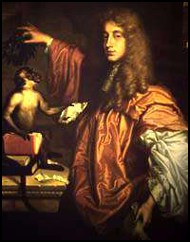Director's Notes
I fell in love with this play almost two years ago. It is, to me, soaringly poetic, and speaks feelingly about passion, hope, love, despair, and loneliness. I would like to profusely thank the many people who have cared passionately about this production and devoted much work to making the show wonderful. I would like to thank all the members of my talented and hard-working cast, and especially Kevin Kindlin, for bravely taking this journey with me.
-Gillian Bagwell
JOHN WILMOT, SECOND EARL OF ROCHESTER
Rochester was born on April 1, 1647 and died on July 26, 1680. This play depicts actual people and events in his life, though the playwright notes, "For dramatic reasons, I have slightly compressed and rearranged events in Rochester's life, without, I hope, distorting the historical record." Etherege, Sackville, Harris, Charles II, Elizabeth Malet, and Elizabeth Barry were real people. Jane, Alcock, Luscombe, Downs and the others are fictional composites, based to varying extents on real people. Rochester and other wits were involved in an "affray" at Epsom, in which a man named Downs met the same fate as Billy. Jane draws heavily on the personality of Nell Gwynn, who was a friend of Rochester's.
THE RESTORATION PERIOD
Charles I was removed from the throne by Cromwell and his faction, and beheaded in 1649. His son Charles was smuggled out of England in disguise and lived in impoverished exile in Europe, accompanied by Royalist supporters such as John Wilmot's father, the first Earl of Rochester. During the Protectorate under Cromwell, many traditional enjoyments were outlawed, including the theatre. Charles II was restored to the throne in 1660, and rode into London in triumph on his birthday, May 29, to wild rejoicing from the populace. One of his first acts as king was to reopen the playhouses, and for the first time, women instead of boys played the female roles. This was a titillating novelty. The actresses were avidly pursued, and many of them left the stage to become the mistresses of wealthy gentlemen. Perhaps the best known is Nell Gwynn, who had risen from the slums to become an orange girl and then an actress at the theatre, and was Charles II's mistress for many years.
FOR FURTHER INFORMATION ABOUT ROCHESTER AND THE PERIOD:
Lord Rochester's Monkey - biography by Graham Greene
Rake Rochester - biography by Charles Norman
The Illustrated Pepys - excerpts from Samuel Pepys' diary edited by Robert Latham
Restoration London by Liza Picard
Plague and Fire: London 1665-66 by Leonard W. Cowie

John Wilmot
The Second Earl of Rochester